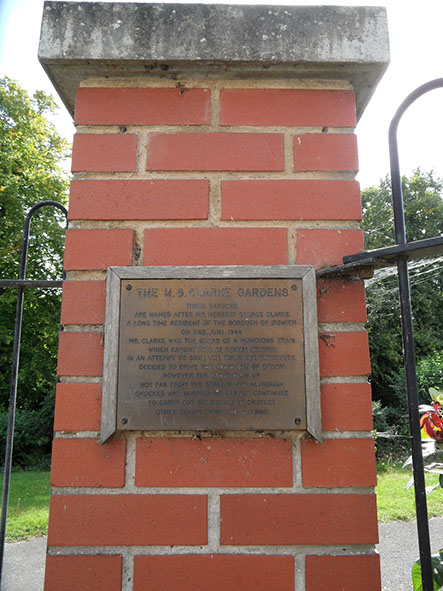- Screen Colours:
- Normal
- Black & Yellow
Railways were an important part of the war effort in World War II. Railway employees were in reserved occupations to ensure that the extensive rail network operated. The field of battle was not the only place where actions of extreme courage by ‘ordinary’ people are enacted, as this incident exemplifies.
Driver Benjamin Gimbert and Fireman James Nightall were on the footplate of the locomotive Austerity on the night of 2 June, 1942, travelling from Ely to Soham with a train of 51 wagons. They were loaded with bombs bound for the US Air Force bases in the region for delivery to targets in Germany. On the way to Soham, the driver glanced round and noticed to his alarm that the truck just behind the locomotive was on fire – it contained forty-four 500-pound bombs, unfused but full of high explosive. He applied the brake gently to avoid jarring the load.
Driver Gimbert and Fireman Nightall knew that they had to try to detach the burning wagon from the remainder of the train to avoid a massive explosion. The train was now travelling around 20 miles per hour, but it took about half a mile to come to a halt. By that time they were approaching Soham station.
Jim Nightall jumped down from the footplate and went to uncouple the burning truck from the rest of the train; he remounted, then Driver Gimbert opened the regulator to ease forward. “I proceeded with the wagon, which was on fire, intending to get it well clear of the station and surrounding buildings, and leave it there and proceed to Fordham,” driver Gimbert later said in his official report. “On approaching the station I gave a second touch on the whistle to draw the signalman’s attention, and as my engine rolled towards him on the platform I went over to my mate’s side, namely to the right-hand side of the engine, and shouted to him to stop the mail and asked if the road to Fordham was clear.”
 He never received an answer for, at that moment all the bombs in the truck exploded, the explosion being heard many miles away. Jim Nightall was killed and signalman F. Bridges died later that day in hospital. Driver Gimbert somehow survived, though in his first three days in hospital surgeons removed 32 pieces of metal from his body.
He never received an answer for, at that moment all the bombs in the truck exploded, the explosion being heard many miles away. Jim Nightall was killed and signalman F. Bridges died later that day in hospital. Driver Gimbert somehow survived, though in his first three days in hospital surgeons removed 32 pieces of metal from his body.
The guard of the train, Herbert Clarke of Ipswich, was knocked down by the blast as he made his way back to his van at the back of the train. Picking himself up, shocked and injured, he ran back up the line towards Ely, putting down detonators to warn the crew of any approaching train, before he collapsed.
Soham station was destroyed and, where the burning wagon had stood was a crater 66 feet across and 15 feet deep. Buildings all over the town of Soham were wrecked and damaged, but the action of the two men in the cab had prevented a much greater explosion and probably saved thousands of lives in the area.
The George Cross was awarded to Driver Gimbert and (posthumously) to Fireman Nightall. The citation read: “These men knew the danger to which they exposed themselves but chose to put their own safety last.”
In 1960, two Class 47 diesel locomotives were named respectively Benjamin Gimbert GC and James Nightall GC. Local man Herbert George Clarke is commemorated in a pocket park opposite the southern end of Croft Street, Over Stoke, where a plaque can be seen. Its position signifies the huge importance of the early railway in this location and the many railway employees who lived there.
(Based on the article by Bob Malster in the Friends of Ipswich Transport Museum newsletter, The Priory Press, issue 173.)
While the population strove to retain a semblance of ‘ordinary life’ during the war, we are reminded here of the perils which might be just around the corner.
We are grateful to Society member Izzy Lane for reminding us of this extraordinary story and its source, and her hope that the plaque on the park entrance can be cleaned and repaired; also for the photograph.